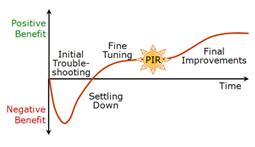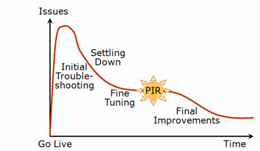The Critical Role of Post Implementation Reviews (PIRs)
Introduction
Whether you’ve successfully delivered a major project or called for an early halt to a project, it’s an ideal time for a Post Implementation Review (PIR). These reviews are pivotal for celebrating successes and creating a pathway for improvements.
What is the purpose of a Post Implementation Review?
A PIR or post-project review isn’t just a tick-box exercise at the end of a project. It’s a powerful tool for introspection and doing things differently. Here’s why it’s important:
- It’s an opportunity to assess if the project delivered what was promised.
- Evaluate what worked well and where the challenges were.
- Learning from experiences and not repeating mistakes fosters a culture of improvement which will spread to the whole organisation, making it stronger in the long run.
The PIR process is all about hindsight and provides the opportunity to look at the project outcomes and goals openly and honestly to identify improvements and celebrate achievements. At its most simple, it can be a Lessons Learned interview or survey with a few people or groups who were involved or impacted by the project, leading to a summary report (we provide a report template here). A decent post-mortem will likely involve a more thorough investigation, however.
The success of any review is about the ability to engage at all levels and review key aspects of your project lifecycle. Ideally, the review needs to be impartial and a collaborative assessment to make sure biases and internal politics are set aside. This collaborative spirit fosters an environment where constructive criticism can flourish, leading to actionable insights that drive ongoing improvement so skilled external consultants can provide valuable objectivity that less neutral stakeholders may struggle to offer.
When should a Post Implementation Review be done?
Timing is a critical factor in the effectiveness of a Project Post Implementation Review. It should occur after the project has been delivered and has had a short time to realise potential benefits. Typically, this review takes place within 2 to 6 months post go-live. This approach allows the dust to settle and makes sure we can apply the insights gained while the project is still fresh in everyone’s minds.
A PIR should not be performed while the initial snags are still being dealt with or while users are still being trained, coached, and generally getting used to its operation.
The PIR should be timed to allow the final improvements to be made to generate optimum benefit from the solution. There’s no point in waiting too long as the results are intended to generate that final benefit for the organisation and team.

The insights gained from a PIR pave the way to implementing actions that drive future success. The information gathered helps to identify gaps in project initiation and delivery processes as compared with best practice, enabling improvement for future projects. By learning from successes and challenges, project managers, and teams can become more agile, efficient, and better equipped to tackle the complexities of future projects.
Who should be involved in a post-implementation review (PIR)
The following stakeholders are typically involved in a post-implementation or post-project review:
Key decision-makers, project team members including the project manager, project stakeholders, quality assurance/testing team, operations and support teams, and any subject matter experts (SMEs) with expertise in specific aspects of the project should be involved. Those Customers/Users who will be using the implemented system or benefiting from the project outcomes should be also involved and, if applicable, you could also involve relevant external vendors or contractors.
Including those involved in the project means that you should have a diverse group of stakeholders and will make sure different perspectives and insights are considered during the review process. The feedback you will collect, and lessons learned from each group can contribute to a more comprehensive understanding of the project’s strengths and areas for improvement. Additionally, involving end-users and customers helps to assess the real-world impact and usability of the implemented solution.

What topics are likely to be covered in a PIR?
- Project Governance
- Project People
- Project Delivery
- Change Management
- Project Scope Management
- Quality Assurance – Content and App Delivery
- Vendor Engagement and Management
- Project Initiation Processes and Planning Key project documentation such as the Business Case, Charter, Scope, Schedule and Budget, etc will be reviewed to ensure they are aligned and that all implicit requirements and deliverables were recognised
What is the PIR process when using external consultants?
Without wishing to make the review a time-consuming process, a PIR is unlikely to bring real value to your organisation without:
- Determining the approach and scope of the PIR
- Obtaining feedback from important stakeholders, teams, and user groups through facilitated workshops and meetings and/or conducting an anonymous survey
- A review of key project documents
- Analysis of project management processes, metrics, and deliverables
- Analysis of change management processes, metrics, and deliverables with a strong focus on organisational adoption and improving the future readiness of the organisation for subsequent changes
- Assessment of the project’s benefits as originally envisaged, actually achieved to date, and yet to come
- Documenting information about the project and reporting on findings and recommendations
What are the benefits of conducting a PIR?
- Reduces cost (learn where costs could be avoided)
- Helps improve/ maximise ROI
- Increases productivity in future projects
- Reduces risk in future projects
- Provides an understanding the things that lead to project failure/success
- Identifies opportunities for improvement/growth
- Provides an understanding of the differences between the original scope and result
- Provides an analysis of team performance
- Identifies whether the project methodology suited the project/organisation
- Identifies what good practices you should apply to future projects
- Make recommendations that identify what actions to avoid in future projects
- Identifies how to better support your people during projects
What questions are asked in a PIR survey?
The questions asked in a PIR survey will depend on the exact nature of the audience the survey is intended for, but are likely to include at least:
- Were the project goals and objectives clearly defined?
- Were the project deliverables completed within the planned budget and time frame?
- Did the project team have the necessary resources to complete the project?
- Was the project management process effective?
- What went well during the project?
- What could have been improved?
- Were there any issues or challenges that arose during the project?
- Were the project stakeholders satisfied with the outcome?
- What lessons were learned from the project?
How does Millpond help with Post implementation reviews?
Millpond’s PIR approach is based on many years of experience. With the strong facilitation and analysis skills provided by our consultants, we can support you in confirming where your team has done well, and identifying where the organisation can do better. As an independent team, we can either solely undertake the review or work in consultation with the business users and project team.
Facilitating is about engaging within the project team at the right level and drawing out the information needed for the review. This allows the team to feel safe in the conversation, while clearly identifying what has gone well and evaluating whether it may be enhanced, and what has gone not so well and may be improved.
Conclusion
In conclusion, project post-implementation reviews are not a mere formality at the end of a project. It’s a commitment to learning, being agile, and adapting to challenges. Embracing the opportunity to reflect on each project becomes a vehicle for quicker delivery of sustainable outcomes.
If you’d like to discuss how Millpond can help you with your PIR, please get in touch.
Not quite what you’re looking for?
Other blogs
of interest







